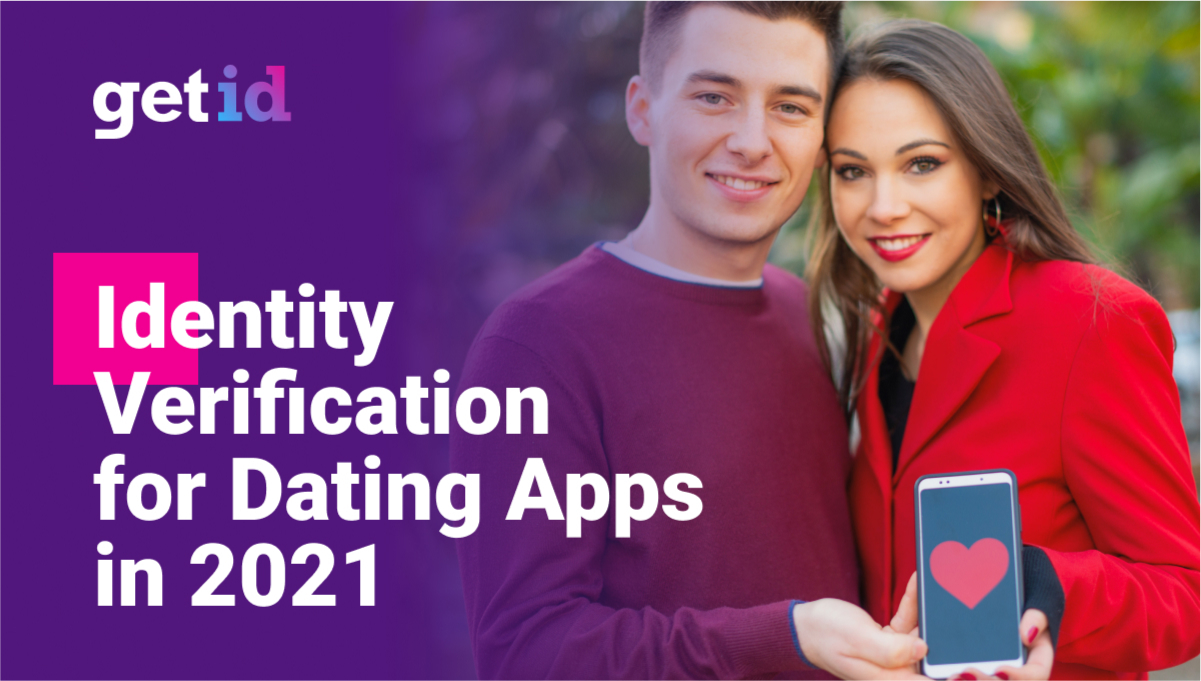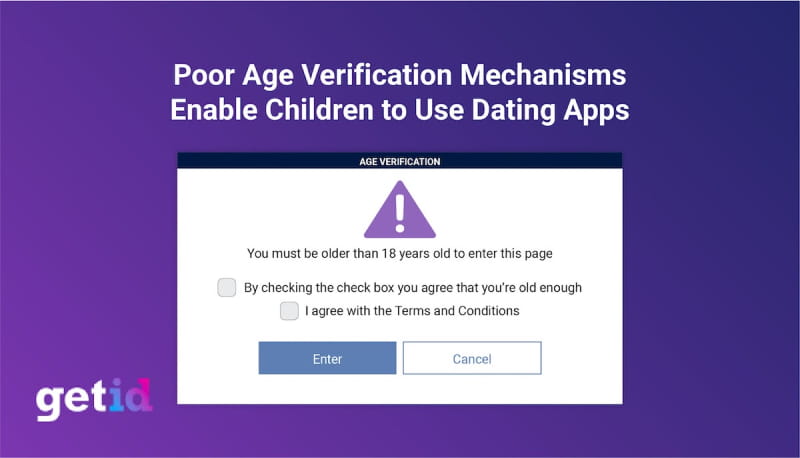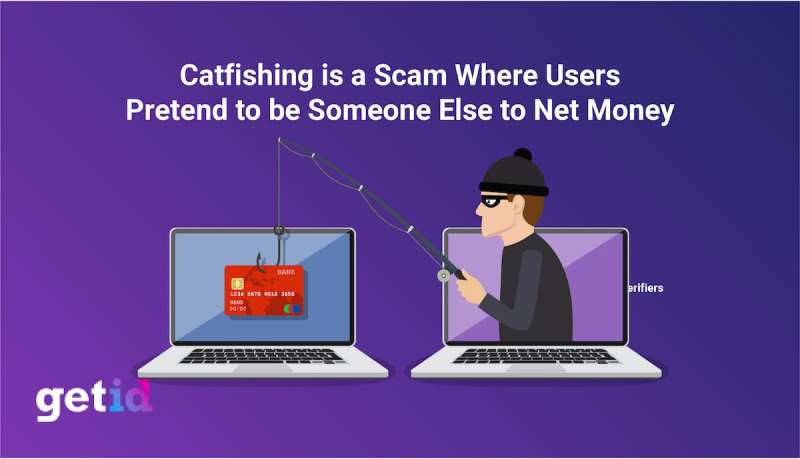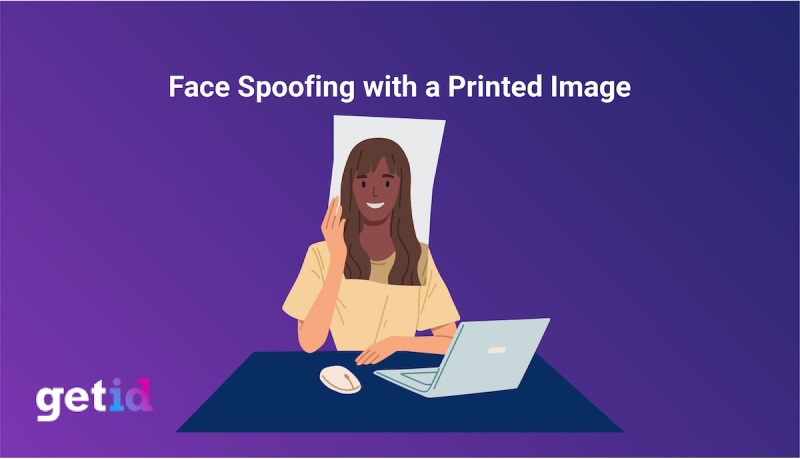
How Identity Verification Shields You from the Dangers of Dating Apps in 2021
3 Jun 2020
Introduction
Online dating has exploded in popularity in the past few years.
Unfortunately, dating websites and apps are hotbeds for scammers, criminals, violent abusers, and sexual predators.
And while streamlined onboarding makes using these tools quicker and easier than ever before, the lack of online dating identity verification procedures is shocking. Without solid identity authentication procedures, users are left vulnerable to potential fraudsters and malicious actors.
GetID is aiming to provide a safeguarding solution: our omnichannel identity verification system that enables apps to guarantee user security.
Thanks to robust GetID’s biometric verification techniques, dating apps can build brand trust by mitigating the risks of unverified users — such as predators, scammers, account hijackers, and catfish attackers. With such rigorous safety measures in place,
Protect your users and increase your dating app’s brand appeal by signing up for a GetID online identity verification today. Still unsure of how GetID can protect you on dating apps? Here’s how.
Dating App Challenges – A Case for ID Verification
30% of US adults have tried online dating, with 12% finding long-term companionship from the process.
Dating apps are here to stay.
For this reason, it’s important to ensure that users can trust dating websites and apps and feel safe when using them and interacting with other users. This means addressing the biggest challenges of dating apps head-on, with identity verification at the heart of the solution to improve trust and safety.
Avoiding Sexual Abuse and Violent Attacks
Perhaps one of the most serious and frightening challenges that face dating apps and websites is the vulnerability to sexual abuse and attacks.
A threat to both adults and children, these violent episodes could be reduced with the introduction of more robust identity verification methods for users.
ID Verification Can Help Weed Out Sexual Predators
Studies show that sexual attacks related to dating apps are on the rise, having doubled in the last four years. This begs the question as to what safety mechanisms are being put in place to tackle this issue.
Consider the case of Katherine Fisher, a 26-year-old who was stabbed to death by a date she met on Plenty of Fish. Alternatively, think about Glenn Hartland, the Melbourne-based Tinder rapist, who was charged with three counts of rape and one count of sexual assault against girls he met on the dating app.
In both of these cases, as with many similar stories. These attackers used fake identities to prey on their victims. Had these apps deployed rigid identity verification protocols, these tragedies may not have occurred.
Dating apps, such as Plenty of Fish, OKCupid, and Tinder, have been accused of enabling known sexual predators thanks to their lack of screening mechanisms, especially on free accounts.
While these apps claim to be putting safety measures into place, such as the panic button and photo verification tool being introduced on Tinder, there are currently no stringent rules around identity verification for users.
For dating apps, however, keeping users safe should top the list of priorities, even simply for the sake of customer retention. In this sense, the introduction of effective and robust authentication processes, like GetID, should be a must.
ID Verification Can Help to Protect Children
Protecting children against the dangers of the internet is undoubtedly a tricky business. However, simple identity verification tactics, such as age verification, can help to put a barrier between young people and potential predators.
Unfortunately, while dating apps claim to do their best to safeguard children, a recent investigation into Tinder, Bumble, and Grindr showed serious flaws. The investigation, which was launched in January 2020 by Raja Krishnamoorthi, the Chairman of the Subcommittee on Economic and Consumer Policy (USA), found that through enabling underage use, these apps had facilitated 60+ cases of sexual abuse of children and 30 cases of rape of a minor.
From the case of Joseph Meili kidnapping and raping an 11-year-old girl to the 13-year-old boy abused by 21 men, this epidemic of child sexual abuse at the hands of dating apps is unprecedented and entirely unacceptable.
The US Government is attempting to eliminate this issue by targeting dating apps that enable underage users. In 2019, Google and Apple were forced to remove three apps from their stores that were in breach of the Children’s Online Privacy Protection Act which enabled users as young as 12 to use their sites.
The problem is that without strict enforcement of age verification, rebellious children will always slip through the cracks, putting themselves in harm’s way. Simultaneously, without identity verification methods, pedophiles will continue to use fake identities to prey on children using these tools.

Perhaps one of the most frightening admissions is that of a spokesperson for the Match Group. While the Match Group screens users of Match.com (a paid-for service), the company does not screen users on their free apps like Tinder and OkCupid. The representative anonymously commented that “there are definitely registered sex offenders on our free products.”
This is because of the lack of data collected on free accounts combined with the shortage of verification processes means that free dating apps are an easier target for underage users and predators.
GetID poses a very real solution to this problem. Instead of shoddy pop-ups designed to tick bureaucratic boxes, choose age verification procedures that actually protect children.
GetID’s face matching account verification process means that account holders must use biometric technology to verify their ID. To log in to their dating app accounts in the future, users must take a selfie. The face matching software compares these images and verifies the user’s identity.
The onboarding identity verification stage poses the first barrier of entry to underage dating app users. Thanks to biometric verification procedures, underage users will not be able to create an account.
Secondarily, if underage users are attempting to log in through their parents’ accounts, the face match software will not verify the selfie. This rejects the attempt to log in, keeping children out of your dating app.
Safeguarding Against Scams
Another prominent challenge for dating apps is the ever-evolving face of internet scammers. As quickly as technology advances, as does the remit of cunning scams that accompany these apps.
The major problem for dating apps is a scamming technique quaintly dubbed ‘Catfishing.’ Catfishing is when a user creates a fake identity to fool another user, usually on a dating app. There are many reasons that users pose as a different person with a fake identity, but most often, it is to scam their victims.

Studies show that 53% of people lie on their dating profiles. While this doesn’t mean that over half of people are pretending to be someone else entirely, it does mean that over half of the dating app population is pretending to be something they are not.
The majority of these falsehoods are most likely a mixture of white lies and exaggerations. However, some are more sinister and can lead the victim to huge financial losses or unwitting involvement in criminal activity.
FBI data has shown that catfishing and romance scams have cost US and Canadian victims close to $1 billion from 2016 to 2019. This figure is shocking, with Federal Trade Commission (FTC) reports showing that more money had been lost in romance scams than any other type of fraud in North America.
Unfortunately, romance scams can take many forms and are extremely difficult to detect. Detection is even harder when dating apps have no identity verification procedures in place.
Often catfish will win over the affections of their victims to eventually extort or trick money from them. Common catfish scams involve the perpetrator encouraging the victim to fall in love with them, before pretending to need funds for a personal emergency, such as health care, a sick family member, home damage, a failed business, and so on.
On other occasions, the catfish will claim they want to visit the victim, but they don’t have the money, convincing the victim to give them funds for the trip.
The other, a more serious form of catfishing, involves money laundering and the transfer of criminal goods. Criminal actors will pose as a love interest before asking to send expensive items, large amounts of money, or precious metals to their victims. From there, they ask their victims to post them forward, often claiming they can’t do it from the country they are in. Often these fraudsters will ask victims to use their own money for administrative fees.
While catfishing has come to the forefront of fraud investigations, it is still on the rise. There were 50% more catfish victims in 2019 than there were three years previously. While criminal justice systems and governments can do their level best to investigate these problems after they have happened, it is abundantly clear that preventative measures are needed.
Solid identity verification procedures, like GetID, will help dating apps to root out and deter illegitimate actors in the first place.
Protection From Account Hijacking
Account stealing is a common problem in the online dating world because password verification is a poor security measure. Just last year, OKCupid, was under fire for instances of account hijacking.
Account hijacking is when hackers steal users’ dating accounts. Using password-cracking software, it’s a breeze for account hijackers to enter dating app accounts.
On the one hand, this kind of security breach allows hackers to pose as other users via legitimate accounts. On the other, more serious hand, this gives hackers access to all manner of sensitive personal information.
This kind of security breach is a GDPR nightmare for dating apps. The GDPR (General Data Protection Regulation) is an EU directive that demands strict measures for the collection, storage, and distribution of Personal Identity Information (PII).
Failure to adhere to these regulations results in monumental fines. Studies show that apps like OKCupid (and Grindr and Tinder), who are currently in breach of these regulations, could face fines of up to 4% of the global revenue.
It’s clear, then, that dating apps need to protect account hijacking to avoid shocking fines and customer identity theft.
GetID provides a robust identity verification that nips account hijacking in the bud. Thanks to the cutting-edge precision of our identity verification technologies, dating app users can securely lock their accounts with biometric security.
Dating app users harness GetID’s biometric Face Matching and Liveness Detection software to automatically verify and secure accounts.
To log back in, users simply take a selfie and GetID’s face matching technology verifies the authenticity of the person logging in.
This means only real users can access their accounts, while account hijackers are kicked out.
In this light, GetID enhances your dating app’s security and protects you from the wrath of the GDPR.
Equally, however, GetID’s ID verification also boosts trust between users. An increase in user trust increases account signups, subscriptions, and usage.
Top-level precision security also generates brand trust with your dating app users, as they feel protected by GetID’s biometric security measures — and therefore, your dating app.
How Does Online ID Verification Solve these Issues?
While scams, hacks, and sexual predators may all appear in different forms, they tend to have one thing in common: the use of false identities. Online ID verification enables dating apps to verify users’ identities. That way, it becomes harder for perpetrators to fraudulently pose as fake users, making it safer for dating app users.
Anti-Face Spoofing to Protect Against Catfishing
One of the ways that people catfish a dating app, is to pretend to be another real-life person. Fraudsters do this by stealing photos, videos, and personal information from social media profiles and websites to form a complete 360-degree believable false identity.
Where most free apps don’t employ verification systems, these stolen identities only have to fool the user with whom the catfish is speaking. On other dating apps, however, users may be asked to complete an extremely rudimentary form of photo verification, as is being seen with Tinder’s new update. These flimsy dating site identity verification processes are easily fooled with simple face spoofing attacks or photo animation apps.
Face spoofing simply refers to the process of tricking a system into pretending to be someone else. This can be as basic as stealing someone’s photograph and posing as a different user or it can be as complex as fooling face recognition systems.
In the latter instance, fraudsters use printed photos, fake 3D masks, looped videos, and warped photographs to create fake profiles. With this in mind, it takes an extremely robust solution, like GetID, to keep these safeguards against such novel attacks.

These attacks have become so commonplace that victims of romance scams and online sexual predators are demanding that dating apps take responsibility. Campaigners are calling on dating companies to enforce systems that check official ID documentation and run applicants against known criminal and predatory databases. However, with the increasing prevalence of fake documentation, perhaps more stringent methods are needed.
Solid online dating identity verification processes can provide an effective means to protect against face spoofing attacks. Using a powerful authentication system, dating apps can better ascertain whether applicants are who they say they are.
Bear in mind that, currently, most free dating apps have absolutely no verification methods. The apps that do ask for photo verification are usually using traditional face recognition technology.
This basic software is easy to fool with printed images as their recognition data points are initially programmed by a human being. Sadly these simple photo verification softwares and age checkboxes act as a cursory nod to user authentication.
Apps mostly employ these techniques to prevent themselves from being penalized by regulatory authorities, rather than to truly keep their users safe. One step verification processes of this kind simply aren’t enough to protect users.
For dating apps to genuinely protect their users, deploying an identity verification system, like GetID, would mean a multi-step verification process that’s far harder to trick. Instead of a simple photo scanner which can be fooled using a printed image, GetID’s state-of-the-art verification system combines automated verification of official documentation, Biometric Facial Recognition technology, and Live Detection software to act as a multifaceted verification solution.
Instead of traditional face recognition, GetID uses cutting-edge deep-learning Biometric Facial Recognition software that harnesses over 32 data points to verify an applicant’s face. GetID’s Liveness Detection system further verifies a user’s identity by asking them to perform a biometric action live on camera that has not been previously determined — Such as smiling or raising eyebrows.
By overlapping these two technologies with Optical Character Recognition, GetID can verify a person is who they claim to be, both in-person and against their official documentation. In this sense, GetID offers a high-tech three-pronged approach that prevents fraudsters from spoofing the system with fake documentation — Or catfishing, as they say.
In fact, GetID’s multi-layered verification system also prevents underage users from bypassing the system. By requiring all users to verify their identity, underage users will now be subject to Biometric Facial Recognition software and Liveness Detection, as well as having to submit official documentation.
While forging documents and fooling age limits is quite basic, spoofing dual biometric systems is an entirely different ball game. This helps to prevent sexual abuse by removing the victim from the situation.
Multi-Layered Verification to Protect Against Scammers
As noted above, most scammers will use catfishing as a technique to fool other users into giving them money. Thanks to GetID’s multi-layered biometric verification systems, scammers won’t be able to fraudulently pose as other people. Instead, dating app users can feel safe in the knowledge that they are only communicating with other verified users.
For further protection, GetID automatically runs applicants against official databases. This process identifies high-risk users who have the potential to act as money laundering scammers.
Our automated system will flag any users who demonstrate suspicious activity in reference to their political position, potential terror funding, and possible criminal activity links. That way, GetID provides dating app users with another layer of protection against possible criminality.
Biometric Login Procedures to Halt Account Hijacking
Stop account hijacking at the door.
Up until now, dating apps have employed password protection to keep user accounts safe. For an account hijacker, hacking these dating apps is a simple process of unleashing a password cracking tool.
Since 81% of data breaches are caused by weak passwords, one-factor password protection doesn’t seem like a wise security choice for your dating app.
Put yourself above the rest with Fort Knox-like biometric security measures. GetID uses facial matching biometric technology to onboard users. This identity verification process ensures that onboarding users are who they say they are.
Face match onboarding also creates a biometric password to lock down user accounts to anybody but the owner. When users log back in, they take a selfie. GetID matches this selfie to the original image, and turfs out any imposters.
That way, account hacking becomes a thing of the past. Dating app users can enjoy unprecedented trust in your online dating community, while you enjoy bolstered brand trust by securely protecting customers.
Why Should Dating Apps Implement GetID’s Identity Verification?
In the context of dating apps, identity verification is a vital element toward safeguarding users. For customers looking to enter the world of dating via an app or website, staying safe in the age of scammers and hackers is imperative.
In this sense, offering potential users the benefits of identity verification from the get-go, enhances your brand image as a trustworthy and conscientious dating platform. By increasing your reputation as a safe online dating option, you widen your target market and increase onboarding.
Currently, 37% of people who don’t use dating apps, claim that this is because they feel unsafe. By implementing identity verification measures to amplify safety, this segment of the market becomes more accessible. In this sense, boosting security and safety thickens your app’s revenue stream by converting previous non-users.
Equally, with such brazen data breaches and safety issues plaguing other dating platforms, GetID offers you a competitive edge. Encourage dating app users to switch platforms by providing identity verification as a safeguarding solution against scammers and hackers — again, increasing your app’s user base and conversion pipeline.
Not only that, but GetID’s succinct automatic identity verification system streamlines onboarding in ways that conventional ID verification cannot.
Traditionally, identity verification procedures require a myriad of third-party verifiers, which could hamper the onboarding process by several days or weeks.
Thankfully, GetID uses automated biometric facial recognition technology, optical character recognition, and database scanning for super-fast verification that streamlines the customer onboarding process.
How Does GetID Work?
GetID offers dating apps a state-of-the-art identity verification solution to boost security and safety, while ensuring full compliance with data regulations.
GetID’s autonomous omnichannel solution combines cutting-edge identification and verification techniques to ensure slick onboarding with immutable accuracy. Here’s how it works:
- Optical Character Recognition (OCR) and software pulls all essential text data from personal documentation;
- Machine Readable Zone (MRZ) software automatically extracts machine-readable data from PII;
- Users take a selfie and submit photographic PII. GetID’s biometric facial recognition software autonomously identifies and verifies a person’s identity based on this image;
- Liveness Detection is used to verify that a person is physically present at the time of onboarding;
- All data is automatically run against official databases to highlight Politically Exposed Persons and those subject to sanctions.
By following these steps, GetID autonomously verifies users and flags any suspicious applicants immediately.
Conclusion
Identity verification is a hot-button topic in the dating app world, following horror stories of violent predators, malicious hackers, and scam artists.
Offering your dating app users a next-generation safeguarding solution will put you ahead of the competition and boost your dating app’s reputation as a trustworthy platform for secure online dating.
With enhanced brand trust, slicker onboarding, and watertight security measures, you’ll enjoy more sign-ups and a healthy boost in revenue.
With such a heightened public demand for identity verification on dating apps, implementing GetID shows your dating app’s commitment to meeting users’ needs in 2020.
Get ahead of the competition today with GetID fully compliant omnichannel identity verification solution that protects your platform and all its users. That way lovebirds can enjoy safe rendezvouses, while you enjoy an upsurge in onboarding from high-quality users.